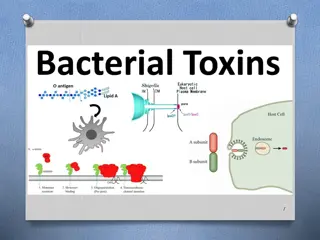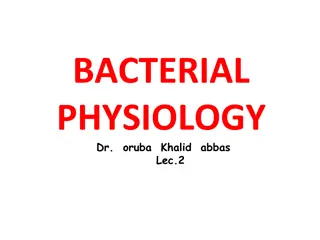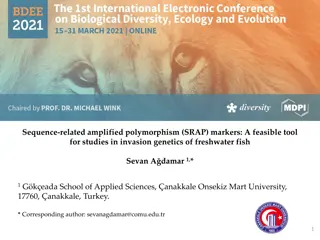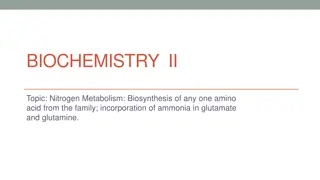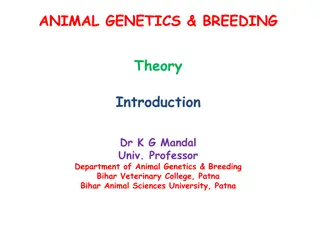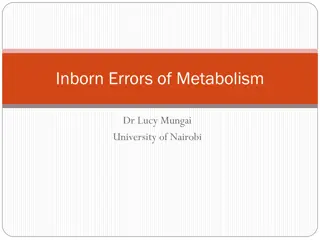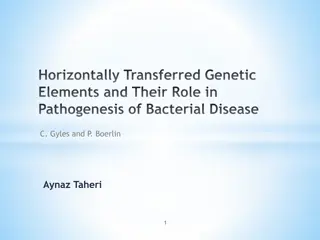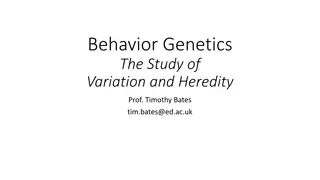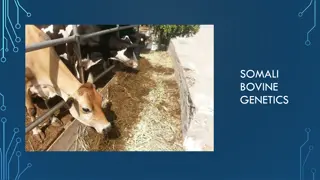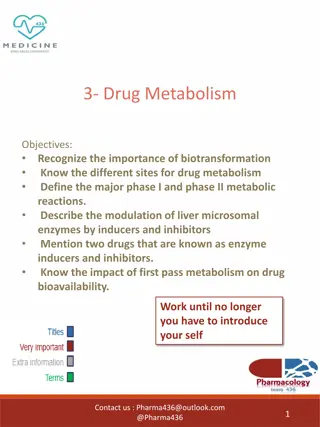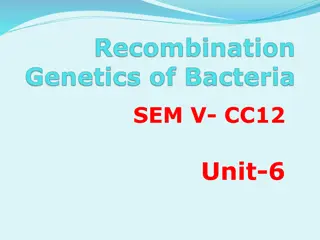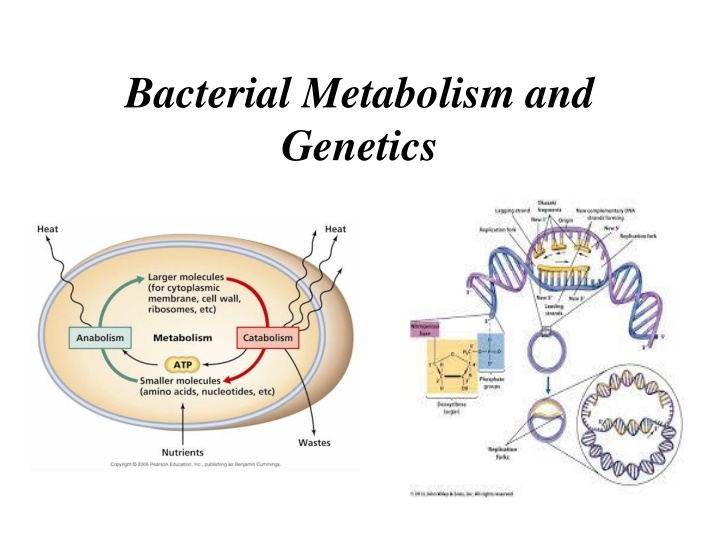
Bacterial Metabolism and Genetics
Explore the world of bacterial metabolism and genetics, where the metabolic reactions within cells mirror those in the human body. Discover the categorization of metabolic reactions, the role of Adenosine triphosphate (ATP), and various methods of catabolizing glucose. Dive into topics like aerobic respiration and the efficiency of extracting energy from glucose. Delve into why bacteria are essential for studying these reactions due to their cost-effectiveness, rapid reproduction, and observable metabolic reactions.
Uploaded on | 1 Views
Download Presentation

Please find below an Image/Link to download the presentation.
The content on the website is provided AS IS for your information and personal use only. It may not be sold, licensed, or shared on other websites without obtaining consent from the author. If you encounter any issues during the download, it is possible that the publisher has removed the file from their server.
You are allowed to download the files provided on this website for personal or commercial use, subject to the condition that they are used lawfully. All files are the property of their respective owners.
The content on the website is provided AS IS for your information and personal use only. It may not be sold, licensed, or shared on other websites without obtaining consent from the author.
E N D
Presentation Transcript
Bacterial Metabolism and Genetics
Bacteria are usually used to study the metabolic reactions that occur within the cell. Why? Because they re inexpensive to maintain in the lab, take up little space, reproduce quickly, their metabolic reactions are easily observable. Metabolic reactions in microbes are similar to those that occur in cells of the human body
Bacterial Metabolism Metabolism: All the chemical reactions (metabolic reactions) that occur within any cell. *Countless chemical reactions take place in cells and are responsible for all the actions of organisms. *Metabolic reactions are regulated by metabolic enzymes.
Bacterial Metabolism Metabolic reactions are categorized into: A) Catabolic reactions (Catabolism) degradative reactions Breaking down the large molecules into smaller molecules and energy is released. B) Anabolic reactions (Anabolism) biosynthetic reactions Assembly (biosynthesis) of smaller molecules into larger molecules and energy is used. Most of the energy that released during catabolic reactions is used in anabolic reactions, and some use in growth, reproduction, movement..etc Table 7-2, page 106
Bacterial Metabolism Adenosine triphosphate (ATP): Energy-storing molecules within a cell. ATP molecules are used to transfer energy from catabolic reactions to the anabolic reactions ATP is energy-carrying molecules Transfer energy from energy-yielding molecules to an energy- requiring molecules
Catabolism Glucose molecules can be catabolized by different methods: Aerobic respiration Anaerobic respiration Fermentation Method of catabolism depends on type of organisms
Aerobic respiration it s the most efficient way to extract energy from glucose. It requires oxygen (aerobic conditions) It involves: 1) Glycolysis 2) Kerbs Cycle 3) Electron transport chain (ETC)
Aerobic respiration 1) Glycolysis: Glucose>> Pyruvic acid + 2 ATP molecules **Oxygen doesn t participate in this phase. 2) Kerbs cycle: enter Kerbs cycle then broke Pyruvic acid>> Acetyl-CoA>> Oxaloacetate + 2 ATP molecules
Aerobic respiration 3) Electron transport chain (ETC): It s Oxidation-reduction reactions. NADH & FADH2 are oxidized>> loss electron and release energy (ATP) The electrons are transferred from one compound to another and finally given to the oxygen (final electron acceptor). Oxygen is the final electron acceptor resulting in formation of water During the ETC>> 32 ATP molecules are produced in prokaryotic cells, 34 ATP in eukaryotic cells
Oxidation-reduction reactions: Electrons are transferred from one compound to another. Oxidation reaction: Loss of an electron. Reduction reaction: Gain of an electron
Aerobic respiration Catabolism of 1 glucose molecule by aerobic respiration produces: 36 ATP molecules in prokaryotic 38 ATP molecules in eukaryotic Table 7-3, page 110
Fermentation Oxygen doesn t participate (anaerobic condition). It involves: 1) Glycolysis 2) Convert pyruvic acid into an end product Catabolism of 1 glucose molecule by fermentation produces 2 ATP molecules.
Fermentation The end product depends on the organism that make the fermentation. Some end products of fermentation have industrial applications while some have harmful effects. Ex: 1. Certain yeasts convert pyruvic acid to ethanol, these yeasts used to make wine 2. Lactic acid bacteria convert pyruvic acid to lactic acid, these bacteria used to make cheese, yogurt 3. Streptococcus spp. (oral bacteria) convert pyruvic acid to lactic acid>> eat teeth enamel>> cause teeth decay
Anabolism Examples of anabolic reactions: 1. Linking a.a molecules >> protein 2. Linking nucleotides molecules >> N.A These reactions require energy. Anabolic reactions are categorized according to the source of energy to: Photosynthesis>> biosynthesis small molecule to larger molecule using sun light energy Chemosynthesis>> biosynthesis small molecule to larger molecule using chemical energy
Define the following terms: Phototrophs Chemotrophs Autotrophs Heterotrophs Photoautotrophs Photoheterotrophs Chemoautotrophs Chemoheterotrophs
Genetics Genetics: study of heredity Nucleic acids (NA):include DNA and RNA, they are large molecules made from nucleotides. Gene:it s a segment of DNA, and it s the fundamental unit of heredity that carry the information needed for protein synthesis. Chromosome:located inside the nucleus and it s made up of DNA coiled around proteins called histones In the nucleus of each cell, the DNA molecule is packaged into thread- like structures called chromosomes. The organism can t produce a particular protein unless it has the gene that codes for this protein
Bacterial Genetics Bacterial Genome: collection of genes A. Chromosome B. Plasmids
Bacterial Genetics A. Bacterial chromosome: Contain circular, ds DNA molecule Bacterial DNA contain about 4000 genes
Bacterial Genetics B. Plasmids: They are extra-chromosomal DNA (circular, ds DNA), and very small in size. Located in the cytoplasm and capable of self- replication. Could be more that one copy / cell. Some plasmids contain many genes, others only few. Not essential for growth. Can carry several characters: virulence, resistance to AB, toxin production .. etc.
Bacterial Gene Transfer A. Vertical gene transfer: Occurs during reproduction, between generation of cells. B. Horizontal gene transfer: Transfer of genes between cells of the same generation. Leads to acquire new genetic information Can be done by: conjugation, transduction, transformation
Horizontal gene transfer (conjugation: bridge-like connection between two cells)
Bacterial Gene Transfer Direct cell to cell contact Conjugation: Is the transfer of genetic material between bacterial cells by direct cell-to-cell contact, or by a bridge-like connection between two cells
Bacterial Gene Transfer Transduction: Transfer of genetic material from one bacterium to another by virus after bacteriophage infection. Transformation: Transfer of genetic material from one bacterium to another by transfer naked DNA from a donor cell to recipient cell, followed by recombination in the recipient chromosome.
Mutation During bacterial reproduction (binary fission) an accidental alteration in the gene can be happen (mutation) and leads to alters the gene product. Mutation is spontaneous and rare (1 mutation/ million cell division) The mutant gene is transmitted to the new generation cells Mutation can be: beneficial, harmful, or silent. Mutation rate can be increased by using some physical or chemical agents (mutagens) that affect the chromosome.
Bacteria can acquire new genetic information by - horizontal gene transfer - and mutation (vertical gene transfer)

